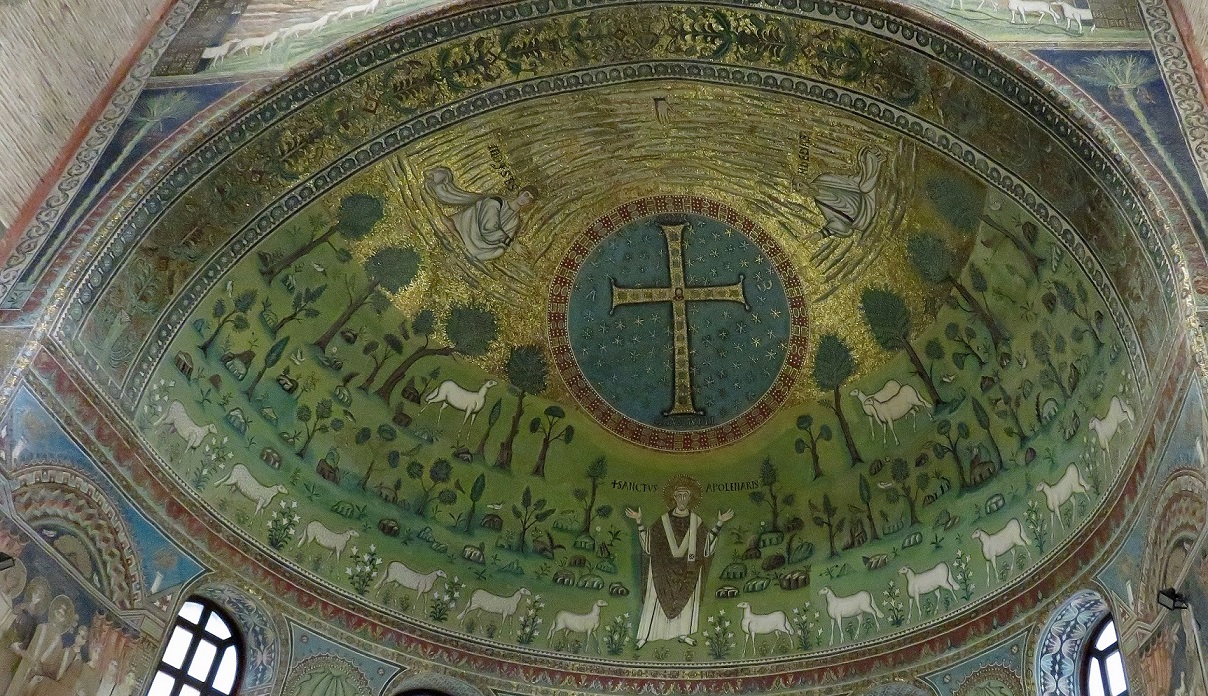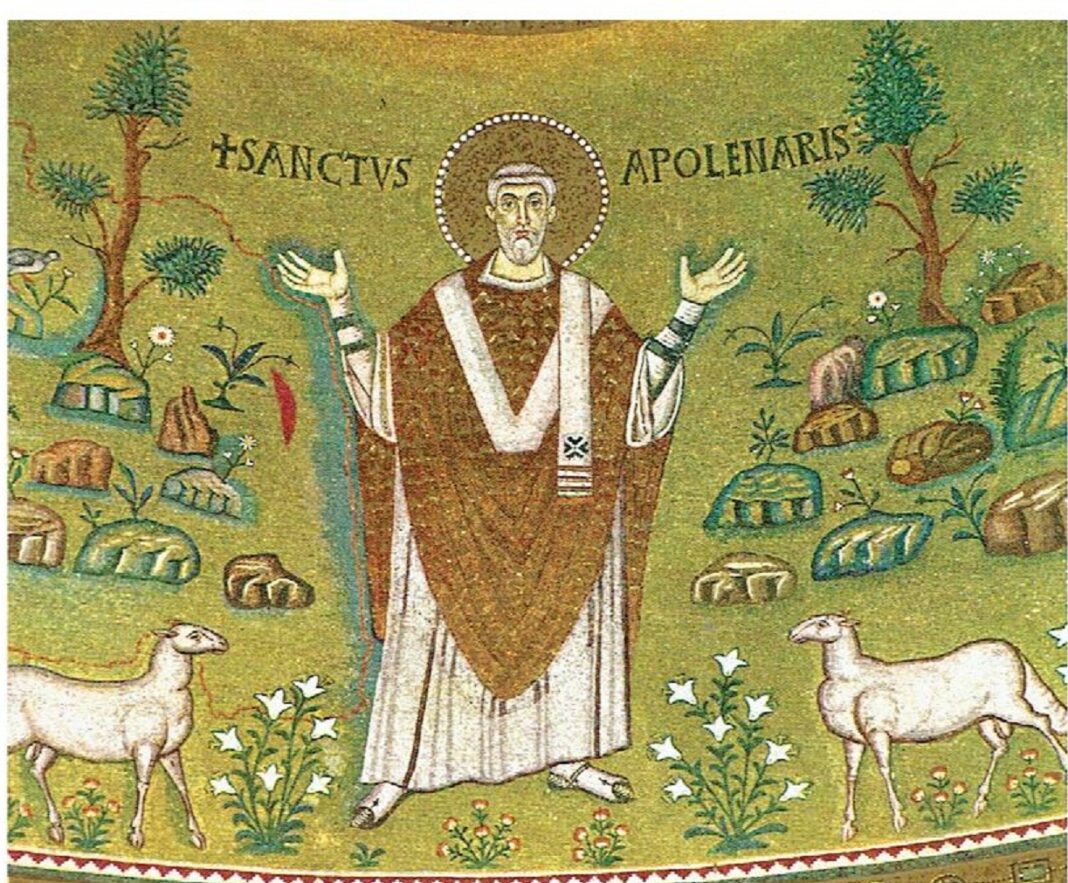Basilica of Sant’ Apollinare in Classe
This unique Byzantine monument, Basilica of Sant’ Apollinare in Classe is not included in the standard tourist itinerary. When UNESCO inscribed eight Ravenna sites on the World Heritage List, it cited this basilica as “an outstanding example of the early Christian basilica in its purity and simplicity of its design and use of space and in the sumptuous nature of its decoration”. A private guide took us to the area that is outside city limits in Ravenna.
We took the 176 Bus line near bicycle stands in the heart of Ravenna. The bus passed rolling fields, fish and fresh produce stands. The church is in a traditional Italian architecture neighborhood with the latest cars. In the front entrance were posters dedicated to a man who saved the Basilica from Allied bombing. The internet and tourist books do not explain in detail what almost happened.
The round bell tower, dating to the 10th century, was rescued in WWII from Anglo-American air-bombardments, the destruction order by the Allied Command and from the German mines planted in their retreat. The basilica tower was used as an observation point for the German army.1 How was the Basilica saved? Lt. Col Vladimir Peniakoff, known as Popski, saved the Basilica with his small group known as ‘Number 2 Demolition Squadron’ of the British army. Major Vladimir Peniakoff was born of Jewish parents in Belgium. The commander and his “Popski’s Private Army” of 35 men advanced to Classe. Popski convinced Germans to retreat adverting a planned Allied massive invasion. They left the Basilica intact, saving this as a site for Western Civilization.
On November 19, 2004, on the 60th Anniversary of the Resistance and of the Struggle for Liberation, the Mayor and People of Ravenna in a commemorative plague ceremony thanked the Partisans, Colonel Popski, the Allies, Clergy and Laypersons for saving their beloved St. Apollinaire in Classe. Popski was a man of the people who appreciated monuments that were of unique art and architecture. A plague in his honor is at the entrance.
Ravenna was the seat of the 5th century Roman and Byzantine Italy until the 8th century.

It has a unique collection of early Christian mosaics and monuments. All eight buildings – the Mausoleum of Galla Placidia, the Neonian Baptistery, the Basilica of Sant’ Apollinare Nuovo, the Arian Baptistery, the Archiepiscopal Chapel, the Mausoleum of Theodoric, the Church of San Vitale and the Basilica of Sant’Apollinare in Classe – were constructed in the 5th and 6th centuries. They show great artistic skill, including a wonderful blend of Graeco-Roman tradition, Christian iconography and oriental and Western styles.
The basilica of Sant’ Apollinare was built 1500 years ago on the seashore at Classe. It was the ancient home port of the Roman fleet. Accumulation of silt-filled the harbor. Now it is dry land. Christianity arrived first in the territory of Classe. It was a cosmopolitan community composed of multiethnic Byzantines. The predominant population was Greek.2
Bishop Ursicinus, using money from the Greek banker Julianus Argentarius, constructed the church. It was located next to a Christian cemetery, and quite possibly on top of a pre-existing pagan one. Some of the ancient pagan tombstones were re-used in its construction. Julianus Argentarius also financed St. Vitale.
Entering the church, the visitor is impressed with the spaciousness, marble Greek columns and the apse. Remnants of the mosaic floor are in showcases. The altar table is directly above the spot of St. Apollinaire’s martyrdom. In the upper apse, is a large disc enclosing a starry sky with a jeweled and the face of Christ in the center. Over the cross is a hand protruding from the clouds, the theme of the Hand of God. At the side of the disc are the figures of Elijah and Moses. The three lambs in the lower sector symbolize the Saints Peter, James and John, alluding to the Transfiguration of Jesus on Mount Tabor.
In the lower apse, is a green valley with rocks, bush, plants and birds. In the middle is the figure of Saint Apollinaris, portrayed in the act of praying God to give grace to his faithful, symbolized by twelve white lambs. At the sides of the apse are two 7th-century panels: the left one, which has largely been restored, portrays the Byzantine Emperor Constantine IV granting privileges to an envoy of the Ravenna’s archbishop. In the right panel are Abraham, Abel and Melchisedek around an altar, on which they offer a sacrifice to God. Sant’Apollinare in Classe was consecrated on 9 May 549 by Bishop Maximian. Early Christian sarcophagi, most of Ravenna archbishops, date from the 5th to 8th centuries, are on the sides.3
The Roman-Byzantine iconography exists after 1500 years. Most Byzantine iconography in Anatolia, the heartland of the Byzantine Empire, has been destroyed. WWII Colonel Popski, who was not of the Christian faith, saved these masterpieces. Her early Christian monuments are cherished, kept alive by the people and the government of Italy. This remarkable nation will rebuild. They are not lost. They will endure. Their soul gives us hope for the future. Sant’ Apollinare in Classe Byzantine mosaics inspire all in a time when we need faith.
References:
1 Bustacchini, Gianfranco. RAVENNA. SALBAROLI PUBLISHERS:2012, p.139.
2.Bustacchini, p. 139.
- https://en.wikipedia.org/wiki/Basilica_of_Sant%27Apollinare_in_Classe
- Bustacchini, p.144
- Scala Group. Ravenna.Tecnostampa, 2016.







